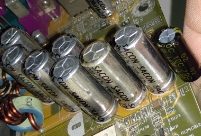Ageve wrote:
On a motherboard (or graphics card), low ESR caps can almost always be used (But don't guess, check the specs for the old ones before replacing).
However, in a PSU you should not use low ESR caps unless the old ones are low ESR as well. The circuit was (hopefully) designed with these caps in mind, and a lower ESR can cause problems in a switched PSU.
On a motherboard, they are usually high performance low ESR or ultra low ESR caps. You can usually polymod these without too much problem.
Power supplies generally use low ESR capacitors as well, but usually do not need as low an ESR as motherboard caps. Getting replacement caps for a power supply is generally not a problem though, places like mouser, element14 and rs-online still sell suitable caps. Do NOT try doing a polymod of an ATX power supply, most of the time, they don't really like it. In fact, you will find that virtually all capacitors in a power supply will be low-ESR, except for maybe a few of the smaller value caps (smaller than 10 uF) and the big primary side capacitors. Generally I find that the primary side capacitors rarely cause problems, so very rare that you would need to replace those, while the small secondary side caps can be replaced with low ESR capacitors and won't substantially effect the circuit.
This is what I have learned from checking out and fixing many PSU units with bad capacitors, with quite a good success rate. I try and catch these problems before the device fails completely and requires more extensive repair.

